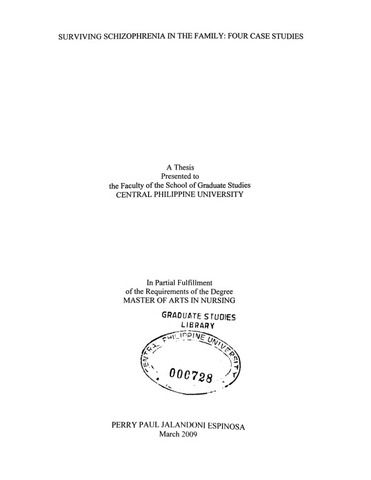| dc.description.abstract | This is a descriptive-qualitative research, case study approach, conducted to describe the coping strategies and problem solving skills of four families with a schizophrenic member.
The participants of the study were the family members of four schizophrenics. Data sources for this study include the key informant interviews with family members, observations, my field notes, and my personal journal. The Holloway’s Strategy was used in analyzing data.
Major Findings
1. Two of the four cases are male and the two are female.
2. The youngest of the four is 25 and the oldest is 53. The two others are aged 38 and 40.
3. Three of them are single; one is married, with three children. One of the singles, however, has two children, out of wedlock.
4. Three of the four have reached college level, while one has only completed high school.
5. Three of them belonged to nuclear type of family, while one is single parent type of family.
6. Moreover, two of the four are considered acute case, the two others are chronic cases. Further, one of them have been diagnosed for two years, the other one for ten years and the two others for more than twenty years, on the other hand however, one of them had remission.
7. Two of the four works independently before they are diagnosed with schizophrenia, one is a fulltime student and the other one is a working student. However, after they are diagnosed, only one of them goes back to work and is very productive, three of them have not gone back to their normal functioning.
8.In terms of family structure, three of them have sibship size of five to six and they are in the fourth or fifth in the birth order specially the males. Moreover, one of the females ranked fifth and has sibship size of six. One is a female first-born.
9. In terms of family monthly income, two of the four have high family income, while the two others have low income.
10. Two of the four has history of mental illness in the family, while the two others have no history.
11. The information that family members have about schizophrenia ranges from having no knowledge to being knowledgeable. The members of the two families have fair to high knowledge. On the other hand, however, one of the family members has highly knowledgeable to it. Furthermore, another family was noted to have poor to fairly knowledgeable about schizophrenia.
12. Most of the family members have congenial relationship with each other. They possess respect and care for one another. They also help the schizophrenic member with their needs.
13. Family members are helping with each other to meet the needs of schizophrenic member. Most of them are directly involved in the care and have shared the responsibility of the mentally-ill member. On the other hand, however, the mother of one of the four schizophrenics carries all the responsibility. Furthermore, most of them accompany their schizophrenic family member when visiting the psychiatrist for consultation and when going to the mall or grocery.
14. The problems and difficulties identified among members of the family are illness-related, eating, hygienic, sleeping, and unclassified behavior. The compliance to medication and treatment are also included.
15. In terms of illness-related problem, the top three coping strategies used by family members are praying, acceptance of the illness, and consulting the doctor (psychiatrist).
16. The family members would then join the client to listen up to the radio, would increase the dosage of the medications or would rather go out of the house even in the wee hours of the morning in order to induce sleep.
17. Families would talk and encourage the schizophrenics to do personal hygiene. They report using many gentle reminders and encouragements to enhance their family member’s personal hygiene and appearance. These constant reminders to “take a bath”, “comb your hair”, “change your clothes”, and “brush your teeth”, appear to be the most common strategy used.
18. In terms of sleeping problem, family members would then join the client to listen up to the radio, would increase the dosage of the medications or would rather go out of the house even in the wee hours of the morning in order to induce sleep.
19. In terms of complying with the medication and treatment, accompanying their schizophrenic to the doctor (psychiatrist) and constantly reminding them to take medications religiously are the most common strategies used. Moreover, family members find physical contact and touching can help to encourage their schizophrenic family member to take the medication.
20. In terms of unclassified behavior (smoking), sitting down and talk calmly on decreasing the number of sticks per day as well as discussing the disadvantages of smoking and emphasizing the value of money are the most commonly reported strategy used. | en_US |


